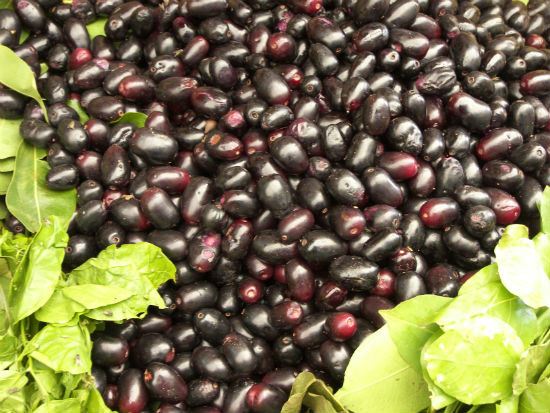Our luscious, glistening royal purple jamun is a very nutritious fruit and much relished due to its iodine content, and adds a greater variety to the diet in terms of colour, flavour and texture. Taken fresh or in processed form, they not only improve the quality of our diet but also provide essential ingredients like carbohydrates, proteins, fats, vitamins and minerals playing a unique role in meeting the nutritional needs of the family.
They have high vitamin A and C content and a fair amount of vitamin B-complex. They make excellent contribution to the calcium and iron levels in the diet and provide minerals, besides, high- quantity fibre for the maintenance of normal gastrointestinal motility.
Glucose and fructose are the principal sugars in the ripe fruit with no trace of sucrose. The anthocyanins in the fruit are responsible for colouring the mouth and tongue purple. The fruits are generally sub-acidic and slightly astringent to taste due to Gallic acid and tannins, but are more palatable in tarts and puddings or when taken with salt. The sweet and mild sour taste of ripe jamun makes it very delicious fruit diet, especially during summer season. The fruit and its juice and the seed contain a biochemical called ʻjambolineʼ and glycoside which checks the conversion of starch into sugar therefore, useful for sugar patients.
Jamun fruits are important in Unani, Chinese and the Indian systems of medicine for curing diabetes, heart and liver problems. The berry is a powerhouse of health, officially named as a diabetes-fighter by the studies conducted by the Indian Journal of Pharmacology, and Bhabha Atomic Research Center and Central Drug Research Institute for its hypoglycemic (lowering blood sugar) properties.
Nutritive value per 100 gm. of jamun fruit
- Protein: 0.7 gm.
- Fat: 0.3 gm.
- Minerals: 0.4 gm.
- Fibre: 0.9 gm.
- Carbohydrates: 14 gm.
- Energy: 62 kcal
- Calcium: 15 mg
- Iron: 1-2 mg
- Phosphorus: 15 mg
- Vitamin C: 18 mg
- Sodium: 26.2 mg
- Potassium: 55 mg
- Magnesium: 35 mg
- Oxalic Acid: 89 mg
- Carotene: 48 mg
- Folic acid: 3 mg
Jamun fruit and leaves are most useful for women during menopause or sterility. Jamun leaves have the power of fertility for females and can be taken with honey at any time of the day on a daily basis for at least a month. An infusion of the fresh tender leaves of jamun fruit prepared by pouring 250 ml of boiling water over 20 gm. of fresh jamun leaves, and allowing it to steep for two hours, is an excellent remedy for sterility or miscarriage due to an ovarian or endometrium functional disorder. The infusion may be taken with either two teaspoons of honey or 200 ml of buttermilk. To get relief from vomiting one can take extracts of Jamun leaves mixed in honey two times a day. The diabetic patient can include jamun fruit and its dried seed powder to control blood sugar level.
Recent medical studies have found that jamun fruit, particularly those from Pakistan’s Punjab region, may help in breast cancer treatments as it seems to inhibit the proliferation of breast cancer cell lines. In addition, studies also show an anticancer potential of jamun fruit extract.
These could be possibly due to several bioactive phytochemicals including polyphenols which have the purple pigment called anthocyanin. Studies show that berry fruit consumption may also provide benefits during chemotherapy and radiation.
In folk medicine people use the fruit, seed powder and bark decoctions when it isnʼt in season to help cure a whole range of ailments, including asthma, sore throats, acidity, nausea, bronchitis, blood impurities, kidney problems, ulcers, spongy gums, stomatitis, arthritis, dyspepsia, dysentery and diarrhea and also serves as an enema.
Medicinally, the fruit is stated to be an astringent, stomachic, carminative, antiscorbutic and diuretic. The juice of the ripe fruit, or a decoction of the fruit, or Jamun vinegar, may be administered in India in cases of enlargement of the spleen, chronic diarrhea and urine retention. The leaves of the Jamun tree possess anti-bacterial properties and are used for making medicines for the strengthening of the teeth and gums.
Jamun leaves, stems, flower buds, opened blossoms, and bark have some antibiotic activity and are helpful as poultices on skin diseases.
Due to its high astringent properties, it is used for gargles and as a mouthwash particularly for bleeding gums (gingivitis). The bark and leaves are useful in controlling high blood pressure. Ashes of the bark, mixed with water, are spread over local inflammations, or blended with oil and applied to burns. Water diluted juice is used as a gargle for sore throat and as a lotion for ringworm of the scalp.
Jamun fruits are highly perishable and can be stored for only up to two days at ambient temperature. Precooled fruits packed in perforated polythene bags can be stored for three weeks at 8-10oC and 85-95 per cent humidity. The fruits can be processed for squashes, sherbets, syrups, jams, jellies, wines, vinegar and juices. The juice cools the body in the heat of summer and quenches thirst. It also helps in the proper functioning of the digestive system due to its extremely soothing and cooling effect. Regular use of Jamun juice helps in managing blood sugar and cholesterol levels, prevents the onset of Alzheimer’s disease, boosts the immune system and helps in slowing down ageing and cartilage deterioration in osteoarthritis.
Cooked to a thick jam, it is eaten to allay acute diarrhea. Some most common home-made jamun recipes are given below for helping you and your family attains healthy life naturally.
Fresh jamun juice: Take 10 jamun fruits per glass, chop and remove the seeds. Blend the fruits, strain it and pour into a glass. Add 1 tsp honey and 1 tsp lemon juice. Chill in the fridge then serve with ice for a really cooling drink.
Jamun fruit jam: Add 500 gm. of well-washed jamun fruits and put them in a thick-bottomed pan. Add water just enough to drown them. Add 1/2 tsp citric acid to it and let it boil for 15 minutes. Let it cool.
Squeeze the juice out of the fruits in the water and sieve it. The seeds and skins will separate. Now, again boil the juice on medium flame along with sugar (half the measurement of the weight of the juice extracted). Stir continuously till the juice thickens into a jam consistency. To check whether the juice has reached the right consistency, drop a drop of the mixture in cold water. If the drop sinks to the bottom as a single blob it signifies that the jam is ready. Remove from heat and store in glass jars.
Jamun mixed jam: Place 250 gm. of well-washed jamuns along with 250 gm. of sugar in a clean, stainless steel pan and stir till the jamuns start to soften. Add a quarter of an apple cut into half-inch pieces. Heat on a medium flame for a few minutes as the juice is released and the sugar acquires a mauve tinge. Mash and remove the seeds when the juice is completely released. Add about half a teaspoon of lime juice. Cook over medium heat till the mixture begins to froth. Add a pinch of finely ground saunf (fennel seeds) as the mixture begins to thicken. To check whether the juice has reached the right consistency, drop a drop of the mixture in cold water. If the drop sinks to the bottom as a single blob it signifies that the jam is ready. Remove from heat and store in glass jars.
Jamun chips are natural strips made from sun-dried Jamun fruit pulp. No artificial sugar, salt, essence or colour is added. It’s good for diabetic patients.
Churan: Jamun fruit and seed are dried with salt and preserved as a digestive powder.














1 comment
This is awesome…I love jamun..as a kid we used to get so much Jamun for free .. Now you have to buy each and everything…It feels bad